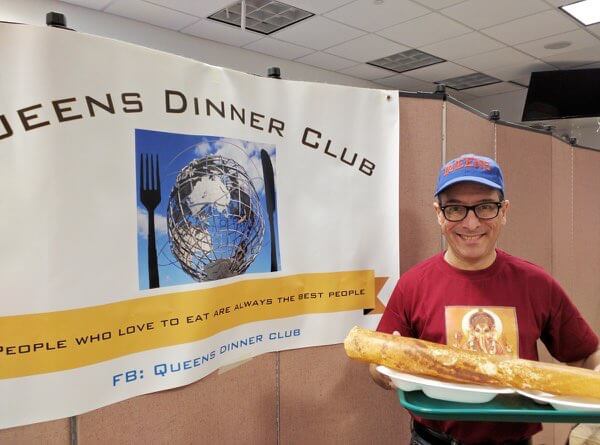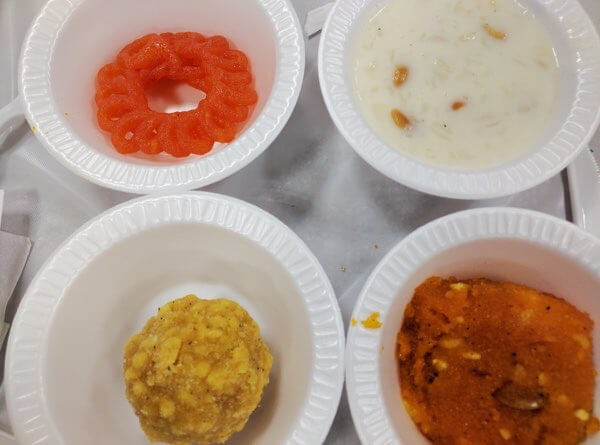By Suzanne Parker
Those Queens-centric food fanatics, Joe Distefano, Gabe Gross, and Jonathan Forgash — collectively known as the Queens Dinner Club — have been at it again.
Their thing is to provide a congenial crowd of Queens gastronomes with unique culinary experiences in settings that might be overlooked by someone who is not an aficionado of the featured culture. The lads’ latest adventure added a new dimension to their scope — spirituality. It was held at the canteen of the Hindu Temple Society of North America in Flushing.
The Ganesh Temple, as it is informally known, is poised to celebrate its 40th anniversary on Bowne Street. After removing our shoes, our group was led on a tour of the temple’s main sanctuary, which houses impressive granite statuary of the major Hindu deities, elaborately decorated and festooned with garlands of flowers.
The most imposing is the majestic statue of Lord Ganesh, the much-beloved elephant-headed god, regarded by Hindus as the overcomer of obstacles. Because of this, worshipers often come here to be blessed when embarking on a new endeavor, such as a marriage, a new business, or even the beginning of a new school year. It is not unusual to see families, with offspring in tow, while a priest performs a rite involving the child’s school books.
The Ganesh Temple was founded in 1977 by a group of Dravidians, or South Indians, and this has conferred a blessing of another kind on Queens food lovers. It has long been an open secret that the temple’s basement canteen serves some of the best South Indian fare to be found in a borough already famous for its Subcontinental cuisine.
In addition to being delicious, their cuisine is strictly vegetarian, mostly vegan and largely gluten free. Although some of the dishes are made with yogurt, (and their mango lassi is divine), coconut milk is more prevalent than dairy, and rice and lentil flour are frequently use instead of wheat. This is a place that can fulfill just about anybody’s diet requirements, however persnickety.
The conviviality of the group assembled in the temple’s basement made up for the high school cafeteria ambiance. Although alcohol was forbidden, the crowd was lively. After a brief welcome from event organizer Joe Distefano, the procession of four courses commenced.
Onion pakora, crispy batter-fried bits of onion, accompanied by South Indians’ favorite condiment, coconut chutney, was the first to arrive. It was a snackish precursor of the tasty things come.
The second course involved an assortment of vegetarian curries, presented in divided Styrofoam serving containers. Kottu curry, a Keralan specialty, had chunks of plantain, easily mistaken for potato, nestled in a base of spicy chickpeas. Vanyaka koora was a pleasingly spicy eggplant dish from Andhra Pradesh. Besibele bhath was a piquant mixture of rice and lentils with mixed vegetables. All of this was accompanied by yogurt rice, seasoned with ginger and chilies, and a dish of classic mixed pickles for added heat.
This was homey South Indian fare not often found in the typical Indian restaurants around town that seem to emphasize Punjabi menus. It was a special pleasure being able to sample some lesser known items. And the diversity of flavors makes a persuasive case for considering vegetarianism.
Perhaps the signature dish of South Indian cooking, dosas, arrived in a trio for our third course. All three are made from a similar batter of soaked lentils, soaked rice, and spices. They’re always served with sambar, a lentil-based vegetable soup and coconut chutney for dipping. Paper dosa, as the name implies, are thin and crisp, and best enjoyed by tearing off pieces with your hands and dipping them in the sauces. Masala dosa are filled with a spicy potato filling. Uttapam is a thick, onion-and-chili version of the same. Although we were especially beguiled by the delicacy of the paper dosa, all were perfectly executed.
A quartet of desserts made up the finale. Indian desserts tend to be ultra-sweet, and these were no exception. They are also not, by any stretch of the imagination, light. We managed a nibble of each, paying special attention to the laddu — a glob of very sweet, spicy, fragrant dough — as that was billed as Ganesh’s favorite.
The Bottom Line
We have the Queens Dinner Club to thank for enabling a wonderful culinary experience. Join the Queens Dinner Club e-mail list by visiting their Facebook page (faceb
And feel free to enjoy the culinary and cultural delights of the Ganesh Temple anytime on your own.
All are welcome.



































